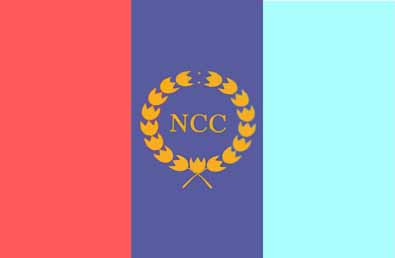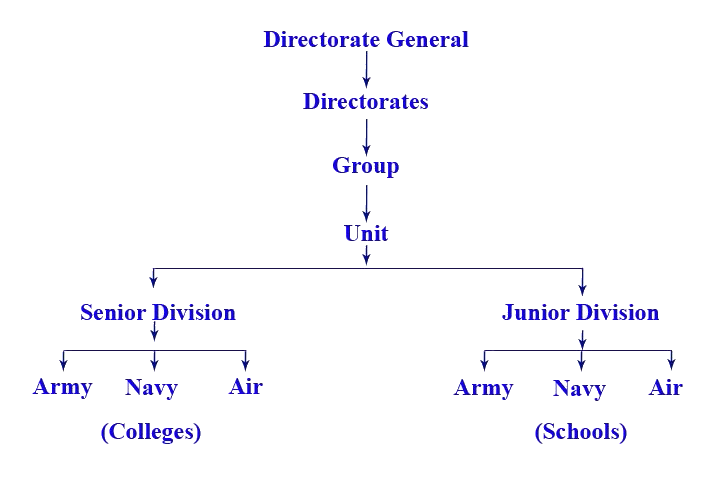The National Cadet Corps (NCC) is the youth wing of the Indian Armed Forces with its headquarters in New Delhi, India. It is open to school and college students on voluntary basis as a Tri-Services Organisation, comprising the Army, the Navy and the Air Force. Cadets are given basic military training in small arms and drill. Officers and cadets have no liability for active military service once they complete their course.
NCC FLAG

The NCC flag for various units of the NCC was first introduced in 1951. The first flag was of the same pattern, colour and size as used by various regiments of the Army. The only difference was that it had the NCC badge and unit designation placed in the centre. Later on, it was felt that the flag should be designed in keeping the inter-service character of the Corps. In 1954 the existing Tri-colour flag was introduced. The three colours in the flag depict the three services of the Corps, red for the Army, deep blue for the Navy and light blue for the Air Force. The letters NCC and the NCC crest in gold in the middle of the flag encircled by a wreath of lotus, give the flag a colourful look and a distinct identity.
ESTABILISMENT OF NCC SONG
- An Official Song of the NCC titled “Kadam Mila Ke Chal” was adopted in 1963. This was, however, changed to the current NCC Song titled “Ham Sabh Bhartiya Hain” in Oct 1982. “Ham Sabh Bhartiya Hain” – NCC song is written by Sudarshan Fakir. Ho, Ho, Ho, Ek Hai. Hum Sab Bharatiya Hain.
NCC SONG
Hum Sab Bhartiya Hain, Hum Sab Bhartiya Hain
Apni Manzil Ek Hai,
Ha, Ha, Ha, Ek Hai,
Ho, Ho, Ho, Ek Hai.
Hum Sab Bhartiya Hain.
Kashmir Ki Dharti Rani Hai,
Sartaj Himalaya Hai,
Saadiyon Se Humne Isko Apne Khoon Se Pala Hai
Desh Ki Raksha Ki Khatir Hum Shamshir Utha Lenge,
Hum Shamshir Utha Lenge.
Bikhre Bikhre Taare Hain Hum Lekin Jhilmil Ek Hai,
Ha, Ha, Ha, Ek Hai
Hum Sab Bharatiya Hai.
Mandir Gurudwaare Bhi Hain Yahan
Aur Masjid Bhi Hai Yahan
Girija Ka Hai Ghariyaal Kahin
Mullah ki Kahin Hai Ajaan
Ek Hee Apna Ram Hain, Ek hi Allah Taala Hai,
Ek Hee Allah Taala Hain, Raang Birange Deepak Hain Hum,
lekin Jagmag Ek Hai, Ha Ha Ha Ek Hai, Ho Ho Ho Ek Hai.
Hum Sab Bharatiya Hain, Hum Sab Bharatiya Hain.
HISTORY OF NCC
The NCC in India was formed in 1948. It can be traced back to the ‘University Corps’, which was created under the Indian Defence Act 1917, with the objective to make up for a shortage of personnel in the Army. In 1920, when the Indian Territorial Act was passed, the ‘University Corps’ was replaced by the University Training Corps (UTC).
In 1949, the Girls Division was formed in order to provide equal opportunities to school and college-going girls. The NCC was given an inter-service image in 1950 when the Air Wing was added, followed by the Naval Wing in 1952. In the same year, the NCC curriculum was extended to include community development/social service activities as a part of the NCC syllabus at the behest of Late Pandit Jawaharlal Nehru who took a keen interest in the growth of the NCC. Following the 1962 Sino-Indian War, to meet the requirement of the Nation, NCC training was made compulsory in 1963. This was discontinued in 1968, when the Corps was again made voluntary.
After the 1965 and 1971 wars, the NCC syllabus was revised. Rather than just being a second line of defence, the revised NCC syllabus laid greater stress on developing qualities of leadership and officer like qualities. The military training which the NCC cadets received was reduced and greater importance was given to social service and youth management.
MOTTO OF NCC
- The mottos suggested were “Duty and Discipline”; “Duty, Unity and Discipline”; “Duty and Unity”; “Unity and Discipline”. The final decision for selection of “Unity and Discipline” as motto for the NCC was taken in the 12th CAC meeting held on 12 Oct 1980.
AIMS OF NCC
- The ‘Aims’ of the NCC laid out in 1988 have stood the test of time and continue to meet the requirements expected of it in the current socio–economic scenario of the country. The NCC aims at developing character, comradeship, discipline, a secular outlook, the spirit. Read More do solemnly pledge that we shall always uphold the unity of India.
OATH
“I do hereby solemnly promise that I will serve my motherland most truly and loyally and that, I will abide by the rules and regulations of the National Cadet Corps. Further, under the command and control of my commanding officer will participate in every camp most sincerely and wholeheartedly.”
PLEDGE
“We, the cadets of the national cadet corps, do solemnly pledge that we shall always uphold the unity of India. We resolve to be disciplined and responsible citizens of our nation. We shall undertake positive community service in the spirit of selflessness and concern for our fellow beings.”
ORGANISATION
The NCC is headed by the Director General (DG), an officer of three-star rank. The DG is assisted by two Additional Director Generals (A and B) of two-star rank (major-general, rear-admiral or air vice-marshal). Five Brigadier level officers and other civil officials also assist him.
The Headquarters is located in Delhi. The organisational structure continues as follows:

DIRECTORATES
There are 17 Directorates[7] located in the state capitals headed by an officer of the rank of a Maj Gen from the three Services.
| Director No | Directorates |
| 1 | Andhra Pradesh & Telangana |
| 2 | Bihar & Jharkhand |
| 3 | Delhi |
| 4 | Gujarat & Dadra and Nagar Haveli and Daman and Diu |
| 5 | Jammu & Kashmir and Ladakh |
| 6 | Karnataka & Goa |
| 7 | Kerala & Lakshadweep |
| 8 | Madhya Pradesh & Chhattisgarh |
| 9 | Maharashtra |
| 10 | North East Region (Arunachal Pradesh, Assam, Manipur, Meghalaya, Mizoram, Nagaland, Tripura) |
| 11 | Odisha |
| 12 | Punjab, Haryana, Himachal Pradesh and Chandigarh |
| 13 | Rajasthan |
| 14 | Tamil Nadu, Puducherry and Andaman and Nicobar |
| 15 | Uttarakhand |
| 16 | Uttar Pradesh |
| 17 | West Bengal & Sikkim |
STRENGTH OF NCC
- Army: Each battalion or unit of NCC consists of a number of platoons or coy. For senior division boys each platoon consists of 52 cadets and each coy consists 160 cadets. Each BN has 4 to 7 Coys so each BN carries around 640 to 1120 cadets. A senior wing girls BN consists of 2 to 7 coy means a total of 320 to 1120 cadets. For junior division boys and junior wing girls each troop has 100 cadets, and each BN has at least one troop.
- Navy: For senior division boys each BN or unit consists of 4 to 8 divisions and each division consists of 50 cadets. For senior wing girls’ similar arrangement exists as of senior division boys. For junior division boys and junior wing girls each BN has a troop of 100 cadets.
- Air: For senior division boys and senior wing girls each unit consists of at least 2 fleets each consists of 100 cadets. So, each unit known as Squadron carries around 200 cadets. For junior wing girls and junior division boys each squadron has a troop consisted of 100 cadets.
However, each unit can have up to 24 troops of senior division boys expanding. their strength to 2400 cadets, but this is maximum limit.
RANKS IN SENIOR DIVISION IN NCC
CADET ACTIVITIES
Centrally Organized Camps
- COMBINED ANNUAL TRAINING CAMPS (CATC)
- NATIONAL INTEGRATION CAMPS (NIC)
- HIKIING AND TREKKING CAMP
- ARMY ATTACHMENT CAMP
- ADVANCE LEADERSHIP CAMP (ALC)
- ROCK CLIMBING TRAINING CAMPS (RCTC)
- OVERSEAS DEVLOYMENT CAMP
- ALL INDIA YACHTING REGETTA (AIYR)
- THAL SAINIK CAMP (TSC)
- REPUBLIC DAY CAMP (RDC)
- YOUTH EXCHANGE PROGRAM (YEP)
TRAINING
Total training period for SD and SW is 3 years with an extension of 1 year permissible & training period for JD & JW is of 2 years. Every cadet of the Senior or Junior Division must undergo service training for a period of at least 4 hours per week during the training year. However, no training is carried out during periods when the college or school through which a cadet is enrolled is closed for a vacation. Every cadet of the Senior and Junior Division has undergo service training for a minimum period of 75% of total hours during the annual college and school session. Every cadet (in case of JD, who has completed one full year of training and is in his second year) attends an annual training camp of 9–10 days, also known as National Combined Annual Training Camp. For SD/SW the duration is usually for up to 30 days. At the end of the camp training the cadets receive a certificate of successful completion.
CERTIFICATION& EXAMINATIONS
There are Three Certificates in NCC. Below describes about it from lower value to higher value: –
Certificate – A
- It can be taken by JD/JW cadets of the NCC, during class year 8 and 9 and 10.
- After passing those classes it can’t be obtained.
- The candidate must have attended a minimum 75% of total training periods laid down in the syllabus for the first and second years of JD/JW NCC (All Wings).
- The candidate must have attended one Annual Training Camp.
Certificate – B
- It can be taken by SD/SW cadets of the NCC,
- After class year 10 and those studying for a degree.
- The candidate must have attended a minimum 75% of total training periods laid down in the syllabus for the first and second years of SD/SW NCC (All Wings).
- The cadet must have attended one Annual Training Camp/NIC.
- Cadets who possess Certificate – A will be awarded 10 bonus marks. An air wing cadet must do a minimum 10 Glider launches.
Certificate – C
- Is the highest-level certificate for NCC cadets.
- It can be taken in the third year of training, in the third year of degree course.
- Those who possess a Certificate – B can take it in the first year after their +2, and in the first year of their degree.
- The cadet must have attended two Annual Training Camps or one Annual Training Camp and one of the following: RD Camp Delhi, Centrally Organised Camp, Para Training Camp, Attachment Training with service units, National Integration Camp, Youth Exchange Programme, or Foreign Cruise (Navy Wing only).






